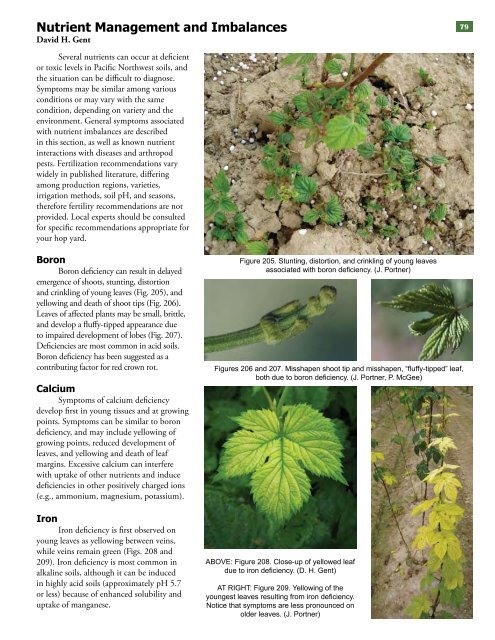Nutrient <strong>Management</strong> and ImbalancesDavid H. Gent79Several nutrients can occur at deficientor toxic levels <strong>in</strong> Pacific Northwest soils, andthe situation can be difficult to diagnose.Symptoms may be similar among variousconditions or may vary with the samecondition, depend<strong>in</strong>g on variety and theenvironment. General symptoms associatedwith nutrient imbalances are described<strong>in</strong> this section, as well as known nutrient<strong>in</strong>teractions with diseases and arthropodpests. Fertilization recommendations varywidely <strong>in</strong> published literature, differ<strong>in</strong>gamong production regions, varieties,irrigation methods, soil pH, and seasons,there<strong>for</strong>e fertility recommendations are notprovided. Local experts should be consulted<strong>for</strong> specific recommendations appropriate <strong>for</strong>your hop yard.BoronBoron deficiency can result <strong>in</strong> delayedemergence of shoots, stunt<strong>in</strong>g, distortionand cr<strong>in</strong>kl<strong>in</strong>g of young leaves (Fig. 205), andyellow<strong>in</strong>g and death of shoot tips (Fig. 206).Leaves of affected plants may be small, brittle,and develop a fluffy-tipped appearance dueto impaired development of lobes (Fig. 207).Deficiencies are most common <strong>in</strong> acid soils.Boron deficiency has been suggested as acontribut<strong>in</strong>g factor <strong>for</strong> red crown rot.CalciumSymptoms of calcium deficiencydevelop first <strong>in</strong> young tissues and at grow<strong>in</strong>gpo<strong>in</strong>ts. Symptoms can be similar to borondeficiency, and may <strong>in</strong>clude yellow<strong>in</strong>g ofgrow<strong>in</strong>g po<strong>in</strong>ts, reduced development ofleaves, and yellow<strong>in</strong>g and death of leafmarg<strong>in</strong>s. Excessive calcium can <strong>in</strong>terferewith uptake of other nutrients and <strong>in</strong>ducedeficiencies <strong>in</strong> other positively charged ions(e.g., ammonium, magnesium, potassium).IronIron deficiency is first observed onyoung leaves as yellow<strong>in</strong>g between ve<strong>in</strong>s,while ve<strong>in</strong>s rema<strong>in</strong> green (Figs. 208 and209). Iron deficiency is most common <strong>in</strong>alkal<strong>in</strong>e soils, although it can be <strong>in</strong>duced<strong>in</strong> highly acid soils (approximately pH 5.7or less) because of enhanced solubility anduptake of manganese.Figure 205. Stunt<strong>in</strong>g, distortion, and cr<strong>in</strong>kl<strong>in</strong>g of young leavesassociated with boron deficiency. (J. Portner)Figures 206 and 207. Misshapen shoot tip and misshapen, “fluffy-tipped” leaf,both due to boron deficiency. (J. Portner, P. McGee)ABOVE: Figure 208. Close-up of yellowed leafdue to iron deficiency. (D. H. Gent)AT RIGHT: Figure 209. Yellow<strong>in</strong>g of theyoungest leaves result<strong>in</strong>g from iron deficiency.Notice that symptoms are less pronounced onolder leaves. (J. Portner)
80Figure 210. Yellow<strong>in</strong>g anddeath of tissue between leafve<strong>in</strong>s caused by magnesiumdeficiency. (C. B. Skotland)Figure 211. Weak growthand yellow<strong>in</strong>g of lower leavesassociated with nitrogendeficiency. (J. Portner)Figure 212. Weak growth andreduced side arm developmentassociated with z<strong>in</strong>c deficiency.(C. B. Skotland)MagnesiumSymptoms appear first on older leavesas yellow<strong>in</strong>g between leaf ve<strong>in</strong>s, followedby death of these areas and defoliation (Fig.210). Magnesium deficiencies are mostcommon <strong>in</strong> acid soils or where excessivepotassium was applied.ManganeseManganese becomes limited <strong>in</strong>high-pH (alkal<strong>in</strong>e) soils and can be presentat toxic levels under low-pH (acidic)conditions. Symptoms of manganesedeficiency are yellow<strong>in</strong>g of young leaves andwhite speckl<strong>in</strong>g. Manganese accumulation<strong>in</strong> plant tissues <strong>in</strong>creases at pH below 5.7,which <strong>in</strong>terferes with iron uptake and can<strong>in</strong>duce an iron deficiency.MolybdenumMolybdenum deficiencies appearfirst <strong>in</strong> older leaves as yellow<strong>in</strong>g and whitespeckl<strong>in</strong>g. Deficiencies have been reportedon hops grown <strong>in</strong> acidic soils (pH 5.7or less). In some plants, molybdenumdeficiency can be misdiagnosed as a nitrogendeficiency s<strong>in</strong>ce affected plants can have ageneral yellow<strong>in</strong>g.NitrogenSymptoms of nitrogen deficiency<strong>in</strong>clude poor growth, stunt<strong>in</strong>g, and a generalyellow<strong>in</strong>g of plants that is most pronouncedon older leaves (Fig. 211). Cones ofnitrogen-deficient plants are smallerthan cones on plants receiv<strong>in</strong>g adequatenitrogen. Excessive nitrogen fertilizationcan <strong>in</strong>crease <strong>in</strong>cidence of several diseasesand arthropod pests, <strong>in</strong>clud<strong>in</strong>g powderymildew, Verticillium wilt, spider mites,and hop aphid. Excessive nitrogen can alsoreduce alpha acid levels of cones. Ef<strong>for</strong>tsshould be taken to balance crop demandswith nitrogen <strong>in</strong>puts and to avoid overapplicationof nitrogen.The <strong>for</strong>m of nitrogen can also affectcerta<strong>in</strong> diseases. Fusarium canker appears tobe favored by ammonium-based nitrogenfertilizers, whereas nitrate-based fertilizersfavor Verticillium wilt. These <strong>in</strong>teractionsprobably <strong>in</strong>volve complex relationshipsbetween the fertilizer components, the soilpH, and the availability of other nutrients(i.e., manganese and z<strong>in</strong>c).PhosphorusSymptoms of deficiency first appearon lower leaves as down-curved, dark-greenleaves with a dull appearance. B<strong>in</strong>es are th<strong>in</strong>and weak. Affected cones may have a browndiscoloration. Studies <strong>in</strong> England <strong>in</strong>dicatethat although symptoms may not be apparent,yield can decrease significantly when hopplants are deficient <strong>in</strong> phosphorous.Excessive phosphorous fertilizationmay <strong>in</strong>duce z<strong>in</strong>c deficiencies, particularly <strong>in</strong>alkal<strong>in</strong>e soils or soils otherwise marg<strong>in</strong>ally deficient<strong>in</strong> z<strong>in</strong>c. Phosphorous acid compoundsoften are applied as foliar fertilizers and cansuppress downy mildew, black root rot, and,to a lesser extent, powdery mildew.PotassiumPotassium deficiency results <strong>in</strong> weakb<strong>in</strong>e growth and reduced burr <strong>for</strong>mation.Symptoms develop first on older leaves,appear<strong>in</strong>g as a bronz<strong>in</strong>g between ve<strong>in</strong>s.These bronze areas become an ashy gray, andleaves may be shed prematurely. Excessivepotassium fertilization also may <strong>in</strong>ducemagnesium deficiencies.SulfurDeficient plants have stunted growth,sp<strong>in</strong>dly stems, and yellow<strong>in</strong>g of younger leaves.Sulfur is commonly deficient <strong>in</strong> the acidic,coarse-textured soils of western Oregon.Z<strong>in</strong>cPlants deficient <strong>in</strong> z<strong>in</strong>c have weakgrowth, short lateral branches, and poorcone production (Fig. 212). Leaves are small,misshapen, yellow, curl upward, and canbecome brittle (Fig. 213). In severe casesaffected plants may die. Z<strong>in</strong>c deficienciesoccur frequently when soil pH is greater than7.5, which is common <strong>in</strong> central Wash<strong>in</strong>gton.Z<strong>in</strong>c applications also can cause remission ofsymptoms associated with Apple mosaic virus.Figure 213. Cupped, brittle leaves caused byz<strong>in</strong>c deficiency. (J. Portner)








